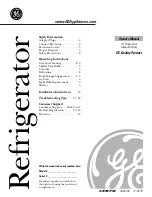
4–7
T-340
Two timers are activated during dehumidification to prevent rapid cycling and consequent contactor wear:
1. Heater debounce timer (three minutes) - The heater debounce timer is started whenever the heater contac
-
tor status is changed. The heat contactor remains energized (or de-energized) for at least three minutes
even if the set point criteria are satisfied.
2. Out-of-range timer (five minutes) - The out-of-range timer is started to maintain heater operation during a
temporary out-of-range condition. If supply air temperature remains outside of the user selected in-range
setting for more than five minutes, the heaters will be de-energized to allow the system to recover. The out-
of-range timer starts as soon as temperature exceeds in-range tolerance value set by Cd30.
4.3.9
Perishable Dehumidification - Bulb Mode
Bulb mode is an extension of dehumidification which allows changes to the evaporator fan speed and/or defrost
termination set points.
Bulb mode is active when Cd35 is set to “Bulb.” Once bulb mode is activated, the user may then change dehumid
-
ification evaporator fan operation from the default (speed alternates from low to high each hour) to constant low or
constant high speed. This is done by toggling Cd36 from its default of “alt” to “Lo” or “Hi” as desired. If low speed
evaporator fan operation is selected, this gives the user the additional capability of selecting dehumidification set
points from 60 to 95% (instead of the normal 65 to 95%).
In addition, if bulb mode is active, Cd37 may be set to override the previous defrost termination thermostat (DTT)
settings. The temperature at which the DTT will be considered “open” may be changed [in 0.1°C(0.2°F) incre
-
ments] to any value between 25.6°C (78°F) and 4°C (39.2°F). The temperature at which the DTT is considered
closed for interval timer start or demand defrost is 10°C (50°F) for “open” values from 25.6°C (78°F)down to a
10°C(50°F) setting. For “open” values lower than 10°C, the “closed” values will decrease to the same value as the
“open” setting. Bulb mode is terminated when:
• Bulb mode code Cd35 is set to “Nor.”
• Dehumidification code Cd33 is set to “Off.”
• The user changes the set point to one that is in the frozen range.
When bulb mode is disabled by any of the above conditions, evaporator fan operation for dehumidification reverts
to “alt” and the DTS termination setting resets to the value determined by CnF41.
4.3.10
Perishable Economy
Economy fan mode is an extension of the Perishable Mode, and is provided for power saving purposes. Economy
fan mode is activated when Cd34 (also used for Frozen Economy Mode) is set to “ON.” Economy fan mode is used
in the transportation of temperature-tolerant cargo or non-respiration items which do not require high airflow for
removing respiration heat.
There is no active display that indicates that economy fan mode has been initiated. To check for economy fan
mode, perform a manual display of Cd34.
In order to initiate economy fan mode, a perishable set point must be selected prior to activation. When economy
fan mode is active, the evaporator fans will be controlled as follows:
At the start of each cooling or heating cycle, the evaporator fans will run in high speed for three minutes.
They will then be switched to low speed any time the supply air temperature is /- 0.2°C (0.36°F) of
the set point and the return air temperature is less than or equal to the supply air tempe3°C (5.4°F).
The fans will continue to run in low speed for one hour. At the end of the hour, the evaporator fans will
switch back to high speed and the cycle will be repeated. If bulb mode is active, economy fan mode will be
overridden.
4.3.11
Perishable Mode Cooling - Sequence of Operation
NOTE
In Standard Perishable Mode, the evaporator motors run in high speed. In Economy Fan Mode, the fan
speed is varied.
a. When supply air temperature is above set point and decreasing, the unit will cool with the condenser fan
motor (CF), compressor motor (CH), and evaporator fan motors (EF) energized, and the white COOL light
illuminated (see
). Also, if current or pressure limiting is not active, the controller will close con
-
tacts TS to open the economizer solenoid valve (ESV) and place the unit in economized operation.
















































